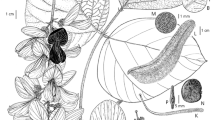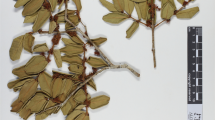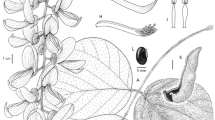Summary
Fruiting material of a Mucuna from Peninsular Thailand with distinctive lamellae proved to be conspecific with M. oligoplax, which was previously thought to have fruit almost lacking lamellae. A revised description and a distribution map for M. oligoplax are presented. This finding also necessitates revision of the key to Mucuna species from the Asian mainland with lamellate pods.
Similar content being viewed by others
Avoid common mistakes on your manuscript.
When first described, Mucuna oligoplax Niyomdham & Wilmot-Dear was known only from a single gathering, Larsen et al. 42455, from Songkhla Province in peninsular Thailand (Wilmot-Dear 1993). The holotype at K (see below) consists of two sheets: one (K000894898) has leaves and mature inflorescences with flowers at anthesis and the other (K000894897) has two lengths of stem, one with the base of an infructescence, plus parts of a loose pod which has a fine pattern of raised vein-lines on the outer surface, several partial and scarcely developed vestiges of lamellae near one margin and remnants of marginal wings. The species was thought to be closest to M. gigantea (Willd.) DC. in its inflorescence and fruit morphology. A second collection with flowers, Mauric 41, also from peninsular Thailand, was made in 1995 (Wilmot-Dear 2009) and then in 2016, two collections were made from a locality in Songkhla Province: Leeratiwong & Komnurdpriwan 16-549, with leaves and flowers just prior to anthesis; and Leeratiwong & Komnurdpriwan 16-550, which lacks vegetative parts and consists of a seed plus several fruits post dehiscence that have a distinctive lamellate surface, apparently not closely resembling any known species. The characters of the first of these two recent collections (leaflet shape and indumentum, inflorescence structure, dimensions of the calyx and corolla, and indumentum on the inflorescence axes) are consistent with M. oligoplax; the short brown indumentum on the under surface of the leaflets is especially distinctive. Features of the second collection (seed shape, colour, patterning and length of hilum, axes, brachyblasts and pedicels in fruiting stage) are also consistent with the type of M. oligoplax, and the pods of these two collections are similar in size, shape, internal surface (silky with ridges between the indentations for the seeds) and number of seeds, the only difference being the lamellae on the pod surface in Leeratiwong & Komnurdpriwan 16-550.
Despite the difference in pod morphology between Larsen et al. 42455 and Leeratiwong & Komnurdpriwan 16-550, the authors are confident that the collections are conspecific and that some variation must occur within this species in the development of the lamellae. An amplified description and discussion of the species’ closest affinities within the genus are here provided, and the key to Thai and Indochinese taxa updated with respect to the species with lamellate fruits, revised from that given in Wilmot-Dear (2008). The position of M. oligoplax in the key to flowering material remains unchanged. Although differences exist between the two fruiting specimens, the delicate pattern of vein-lines on the pod surface is present in both collections and the indumentum on the pod surface is similar, although sparser in Larsen et al. 42455.
According to the protologue (Wilmot-Dear 1993), the holotype of Mucuna oligoplax is at K and although not explicitly stated there, the material at K consists of two sheets, which were labelled by Wilmot-Dear at the time of publication as “holotype 1/ 2” and “holotype 2/ 2”. (In accordance with Article 8.3 of the International Code of Nomenclature (Turland et al. 2018), a holotype may be mounted as more than one preparation, as long as the parts are clearly labelled.) The protologue also indicated the presence of an isotype at L but we have been unable to verify this. No sheet of this number or taxon name was found in the database of collections at L (Naturalis Biodiversity Centre Bioportal (published on the internet)) and so it is omitted from the citation of the type material below.
Mucuna oligoplax Niyomdham & Wilmot-Dear in Wilmot-Dear (1993: 29 & fig. 1).Type: Thailand (peninsula), Songkhla Province, Na Thawe, S of Chana, Khao Nam Khang National Park, 06°45'N, 100°43'E, 100 – 150 m, fl. & old fr., 20 Oct. 1991, Larsen et al. 42455 (holotype K! (consisting of 2 sheets: K000894897, K000894898); isotypes AAU, BKF — image! (20294), MO — image! (MO-04594911), PSU!).
Liana, 10 – 40 m long. Young stems and both sides of leaflets with conspicuous dark red-brown, soft, ± spreading hairs 0.3 – 0.5 mm long. Stipels present. Terminal leaflet 12 – 14 × 7 – 8 cm, elliptic, length 1.5 – 2 × width, apex with short broad acumen. Inflorescence axillary, pseudo-racemose but 2 – 3 main axes arising from the same axil; axis very short and robust, 3 – 4 cm long, 1.5 mm diam., becoming thick and woody in fruit, peduncle 1 – 3 cm long, with dense pale yellowish-orange spreading hairs; rachis 1 – 2.5 cm long; brachyblasts 2 – 5 mm long; bracts narrowly ovate, long-acuminate, 7 × 3.5 mm; pedicels 2.5 – 3.5 cm long, lowest ones often longest giving inflorescence an indistinctly pseudumbellate appearance. Flowers 4.7 – 5.2 cm long; calyx lobes very distinct, median one 6 – 8 mm long, narrowly acuminate, laterals 2 – 3 mm; corolla light greenish-purple with wings darker, standard c. 3 cm long; wings rather narrow, 4.9 – 5.2 × c. 1.2 cm, apex tapering, ± acute, slightly longer than keel, keel ± 4.5 cm long, straight but abruptly upcurved at apex. Pods leathery, flattened-oblong, not constricted between the 2 – 3 seeds, 7 – 10 × 3.7 – 4 × 1 cm, with sparse red-brown hairs (as on the stem) and dense irritant red-brown bristles especially on the lamellae; lamellae simple, running not or only slightly obliquely across face and interrupted along midline of valve, varying from few and poorly-developed to c. 10 – 13 clearly developed ones on adaxial half of each valve, fewer on the abaxial half of the valve, c. 4 mm apart, shallow and those on the abaxial half less well-developed and lower than those on the adaxial half (2 – 5 mm high); near to margins valve surface indented (vertically) between the lamellae such that lamellae appear higher; marginal wing along abaxial margin up to 3 mm wide, along adaxial margin wider (c. 5 mm) and indented (horizontally) where each lamella reaches the wing such that adaxial margin is irregularly and markedly undulate (“frilly”). Seeds discoid or slightly reniform, 2.2 × 1.8 – 2 x 0.9 – 1 cm, shiny light orange-brown mottled with dark brown; hilum black, extending through ¾ of circumference. Fig. 1.
distribution. Thailand, Southern Region (Songkhla, Satun and Trang Provinces). Map 1.
Distribution of Mucuna oligoplax in southern Thailand (produced using SimpleMappr (published on the internet)).
habitat and ecology. Clearings and disturbed areas in evergreen dry forest, rainforest or scrub forest and along stream-sides; 60 – 200 m altitude.
specimens examined. thailand. Songkhla Prov.: Larsen et al. 42455 (type, see above); Sadao Distr., Padang Besar Subdistr., Ban Phadam, [c. 6°40'N, 100°19'E], 200 m, fl., 12 Jan. 2016, Leeratiwong & Komnurdpriwan 16-549 (K!, PSU!); ibid., 200 m, fr., 3 Oct. 2016, Leeratiwong & Komnurdpriwan 16-550 (K!, PSU!). Trang Prov.: Yan Ta Khao Distr., [c. 7°23'N, 99°40'E], fl., 16 Dec. 1995, Mauric 41 (BKF!). Satun Prov.: La-Ngu Distr., [c. 6°54'N, 99°47'E], 60 m, fl., 18 Feb. 2017, Leeratiwong & Jornead 17-1203 (PSU!).
notes. This species is distinctive in its dark red indumentum, slightly lengthened brachyblasts, shallow simple lamellae running only from the midline of the fruit to the edges, not or scarcely oblique, and wing along the adaxial margin of fruit of markedly irregular width. Mucuna monosperma DC. ex Wight (N Thailand) is the most closely similar species with red-brown indumentum, a similarly short inflorescence and fruit lamellae interrupted but due to its fruit shape (a 1-seeded, much shorter, almost ellipsoid fruit, nearly as wide as long) the lamellae all converge towards the middle of the pod; it also has shorter pedicels and corolla, shorter and broader calyx lobes, and dark (rather than pale) purple petals. Mucuna championii Benth. (China) also has reddish (but more orange-red) indumentum, and a longer 3 – 4-seeded pod (length 3 – 4 × width) with markedly oblique lamellae not or rarely interrupted. The long pedicels and slightly lengthened brachyblasts are similar to (although shorter than) those of the widespread M. gigantea which is easily distinguished by pubescence on vegetative parts pale or absent, inflorescence distinctly pseudumbellate, flowers greenish-white with shorter calyx lobes, pedicels and wing petals, no lamellae on the fruits and seeds not mottled.
Revised key to lamellate-fruited species of Mucuna in Thailand, Indochina and Peninsular Malaysia
-
1. Lamellae on fruit surface each a simple raised flap, usually but not always continuous across face.......2
-
1a. Lamellae on fruit surface bifurcated to give a “T” shape in cross-section and all interrupted along mid-line of fruit.......6
-
2. Vegetative parts of plant with fine, deep red, spreading pubescence; fruit with similar hairs and also with coarse red bristles; most lamellae interrupted near middle of fruit; leaflets short-acuminate.......3
-
2a. Vegetative parts of plant with pubescence absent or pale to golden; fruits with bristles but without conspicuous short fine pubescence; most lamellae continuous across face of fruit; leaflets various.......4
-
3. Fruit 2 – 3-seeded, oblong with length c. twice width; lamellae running parallel to one another, not or slightly obliquely across face; lowest (median) calyx lobe narrowly acuminate, 6 – 8 mm long but only up to 1.5 mm wide except at the extreme base; leaflets indistinctly short-acuminate (Peninsular Thailand).......M. oligoplax
-
3a. Fruit 1 (very rarely 2)-seeded, asymmetrically oblong to elliptic, often wider than long and length never more than 1.5 × width; lamellae converging and mostly interrupted towards centre of pod; lowest (median) calyx lobe short and broad, ≤ 4.5 mm long and often 4 mm wide; leaflets abruptly short-acuminate (N Thailand, Indian Subcontinent, Burma, Sri Lanka).......M. monosperma
-
4. Stipels not persistent; fruit linear-oblong, usually 4 – 5 × as long as wide, length 10 – 20 cm with 4 – 6 seeds; lamellae 20 – 25, very shallow of irregular width ≤ 2 mm wide running obliquely across surface; wing ≤ 5 mm wide (cultivated).......M. bennettii
-
4a. Stipels persistent; fruit often shorter and relatively wider, with 1 – 3 seeds; lamellae various; wing various.......5
-
5. Lamellae very irregular in height, 1 – 2 mm but increasing to 4 mm in places and all running to distal edge of wing; wing of irregular width, 3 – 4 mm but widening sharply to 5 – 6 mm at points where lamellae occur, resulting in a jaggedly dentate appearance (Peninsular Malaysia, Peninsular Thailand).......M. stenoplax
-
5a. Lamellae of fairly uniform height, 4 – 5 mm; wing very wide and even, 8 – 14 mm (Vietnam).......M. hainanensis
-
6. Lamellae all extending to distal edge of wing, at which point wing widens sharply to give a jaggedly toothed appearance; calyx lobes extremely short, lowest 1.5 – 4 mm, laterals 0.5 – 2 mm (Peninsular Malaysia, Indonesia).......M. biplicata
-
6a. Lamellae never extending into marginal wing and wing of ± uniform width; calyx lobes long, lowest (6 –) 7 – 10 mm, laterals 4 – 6 mm .......7
-
7. Fruit (1 –) 2-seeded, 6 – 9 × 4 – 4.5 cm; lamellae 8 – 12 in number with strongly revolute apical halves; marginal wings strongly inrolled; floral bracts never persistent; hairs on inflorescence axis and calyx spreading, velvety, very short, 0.1 – 0.2 mm (Thailand, Indochina, China) .......M. revoluta
-
7a. Fruit 3-seeded, 13 – 14 × 6 – 7 cm; lamellae ± 18 in number with spreading or ± upcurved apical halves; marginal wings ± flat or slightly undulate; some floral bracts usually persistent to fruiting stage, these large and conspicuous; hairs on inflorescence axis and calyx adpressed, ≥ 0.4 mm (Thailand, Indochina, China, Burma) .......M. interrupta
References
Naturalis Biodiversity Centre Bioportal (published on the internet). http://bioportal.naturalis.nl/ Accessed Feb. 2019.
SimpleMappr (published on the internet). http://www.simplemappr.net Accessed Sept. 2018.
Turland, N. J., Wiersema, J. H., Barrie, F. R., Greuter, W., Hawksworth, D. L., Herendeen, P. S., Knapp, S., Kusber, W.-H., De-Zhu Li, Marhold, K., May, T. W., McNeill, J., Monro, A. M., Prado, J., Price, M. J. & Smith, G. F. (2018). International Code of Nomenclature for algae, fungi, and plants (Shenzhen Code). Regnum Veg. 159.
Wilmot-Dear, C. M. (1993). A new species of Mucuna (Leguminosae-Phaseoleae) from Thailand, and a revised key to the species in Thailand, Indochina and the Malay Peninsula. Kew Bull. 48: 29 – 35.
Wilmot-Dear , C. M. (2008). Mucuna Adans. (Leguminosae) in Thailand. Thai Forest Bull. Bot. 36: 114 – 139.
Wilmot-Dear , C. M. (2009). Notes on Mucuna (Leguminosae: Phaseoleae) in Thailand. Kew. Bull. 64: 579 – 580.
Author information
Authors and Affiliations
Corresponding author
Additional information
Publisher’s Note
Springer Nature remains neutral with regard to jurisdictional claims in published maps and institutional affiliations.
Rights and permissions
Open Access This article is distributed under the terms of the Creative Commons Attribution 4.0 International License (http://creativecommons.org/licenses/by/4.0/), which permits unrestricted use, distribution, and reproduction in any medium, provided you give appropriate credit to the original author(s) and the source, provide a link to the Creative Commons license, and indicate if changes were made.
About this article
Cite this article
Wilmot-Dear, C.M., Hopkins, H.C.F. & Leeratiwong, C. Notes on Mucuna (Leguminosae: Papilionoideae) in Thailand: fruits of M. oligoplax re-assessed, and a revised key to species with lamellate fruits. Kew Bull 74, 55 (2019). https://doi.org/10.1007/s12225-019-9839-9
Accepted:
Published:
DOI: https://doi.org/10.1007/s12225-019-9839-9






